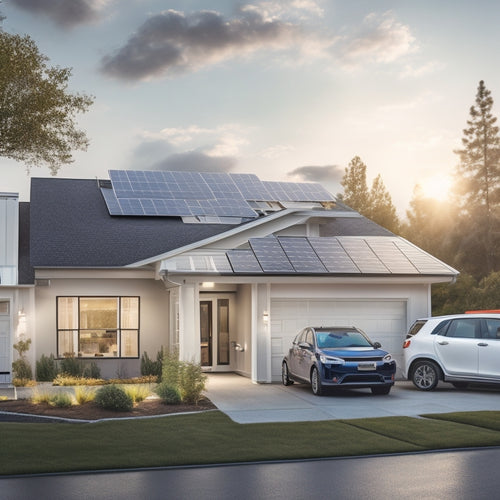
Solar Panel System Price Expectations This Year
Share
You can expect to pay between $15,000 and $30,000 for a typical residential solar panel system this year, depending on the system size, installation costs, and local incentives. Factors like regional market trends, permitting fees, and equipment choices impact the final cost. While inverter and battery prices are on the rise, advancements in technology and economies of scale are driving down overall costs. Government incentives and rebates can further reduce your upfront investment. As you weigh your options, consider the factors that influence pricing, and you'll be well on your way to making an informed decision about your solar panel system.
Key Takeaways
- Solar panel prices are trending downward due to advancements in technology and reduced production costs.
- The average cost of solar panels ranges from $2.50 to $3.50 per watt, with high-efficiency panels exceeding $5 per watt.
- Inverter and battery prices have risen by 10-15% and 12-18%, respectively, due to increased demand for energy storage.
- Government incentives, such as the Federal Tax Credit, and state and local rebates can significantly reduce upfront solar system costs.
- System prices vary by region, with states having high renewable portfolio standards generally having lower prices.
Current Market Trends and Analysis
Analyzing the current solar panel system market, you'll notice a downward trend in prices, driven primarily by advancements in technology and economies of scale. Over the past decade, the industry has witnessed a significant reduction in production costs, which has trickled down to the end-user.
This decline is largely attributed to improvements in manufacturing efficiency, reduced material costs, and optimized supply chain logistics. Technology advancements have also played a vital role, enabling the production of more efficient and cost-effective solar panels.
As the demand for renewable energy continues to rise, manufacturers are scaling up production to meet the increasing demand. This, in turn, has led to a decrease in prices due to the benefits of economies of scale.
Additionally, the streamlining of the supply chain has reduced transportation costs and lead times, making solar panels more accessible and affordable. With these trends expected to continue, it's likely that solar panel system prices will remain competitive, making it an attractive option for those seeking to shift to renewable energy.
Average System Prices by Region
As you investigate the current market trends, you'll find that solar panel system prices vary greatly depending on the region.
Regional price variations are influenced by market demand factors, such as local government incentives, competition among installers, and labor costs. For instance, states with high renewable portfolio standards, like California, tend to have lower system prices due to increased demand and economies of scale.
In regions with high electricity rates, like Hawaii and the Northeast, you'll typically find higher system prices due to the increased value of solar electricity. Conversely, areas with lower electricity rates, like the Midwest, often have lower system prices.
Additionally, regions with high permitting and inspection fees, like Florida, can drive up system costs.
Understanding these regional price variations is essential when evaluating solar panel system prices. By considering local market conditions, you can make a more informed decision when comparing prices from different installers.
Be sure to research regional pricing trends to get the best value for your investment.
Cost of Solar Panels per Watt
When evaluating solar panel system prices, it's vital to take into account the cost of solar panels per watt, which greatly influences the overall system cost.
You'll want to take into account the efficiency of the solar panels, as higher-efficiency panels produce more power per hour of sunlight. This means you'll need fewer panels to generate the same amount of energy, resulting in lower costs.
The cost of solar panels per watt typically ranges from $2.50 to $3.50. However, high-efficiency panels can cost upwards of $5 per watt.
It's important to balance the upfront cost with the long-term benefits of higher-efficiency panels, which often come with longer warranties. Solar panel warranties typically range from 25 to 30 years, with some manufacturers offering up to 40 years.
When calculating the cost of solar panels per watt, you should also take into account the quality of the panels and the manufacturer's reputation.
Look for panels with high-efficiency ratings and detailed warranties to make sure you're getting the best value for your investment.
Installation Costs and Labor Fees
Installed solar panel systems require more than just the panels themselves; a significant portion of the overall cost comes from installation costs and labor fees. As you consider investing in a solar panel system, it's vital to factor in these additional expenses.
When it comes to installation costs and labor fees, you can expect to pay for:
-
Permitting and inspection fees: These fees vary by location and are typically paid to local authorities to guarantee your system meets safety standards.
-
Installation labor costs: The cost of hiring a professional installation team to mount and connect your solar panels.
-
Mounting and tracking system costs: The equipment needed to securely fasten your panels to your roof and optimize their energy output.
-
Electrical system upgrades: Upgrades to your home's electrical system to accommodate the new solar panel system.
-
Financing options and installation timeline: Be sure to ask about financing options and the expected installation timeline to guarantee a smooth process.
Remember to factor these costs into your overall budget to get an accurate estimate of your solar panel system's total cost.
Inverter and Battery Prices Rising
Your solar panel system's inverters and batteries play an essential role in converting and storing energy, but their prices are on the rise. This increase is largely due to advancements in inverter technology, which have led to more efficient and reliable systems, but also more expensive ones. Additionally, the growing demand for energy storage solutions has driven up the cost of batteries, making them a significant contributor to the overall system cost.
| Component | Price Increase |
|---|---|
| Inverters | 10-15% |
| Batteries | 12-18% |
| Inverter-Battery Combo | 15-20% |
| High-Capacity Batteries | 20-25% |
As you consider your solar panel system, keep in mind that these price increases will impact your overall costs. However, the benefits of advanced inverter technology and improved battery longevity may justify the additional expense. Be sure to weigh the pros and cons and discuss your options with your solar panel professional to determine the best solution for your energy needs.
Government Incentives and Rebates
You'll want to factor in government incentives and rebates when calculating the overall cost of your solar panel system.
The Federal Tax Credit, for instance, can greatly reduce your system's upfront cost.
Additionally, you may be eligible for state and local incentives, as well as utility rebate programs, which can further offset your expenses.
Federal Tax Credit
Owning a solar panel system can considerably reduce your tax liability, thanks to the Federal Tax Credit. As a homeowner, you're eligible for a tax credit of up to 26% of the total cost of your solar panel system. This credit can be claimed on your federal income tax return, reducing the amount of taxes you owe.
To take advantage of the Federal Tax Credit, you'll need to meet certain tax credit eligibility requirements. Here are some key points to evaluate:
- You must have a tax liability to claim the credit.
- The solar panel system must be installed and generating electricity during the tax year.
- You must own the solar panel system (leasing doesn't qualify).
- The system must meet all applicable building codes and local ordinances.
- You'll need to complete the tax credit application (Form 5695) and attach it to your tax return.
State and Local Incentives
Beyond the federal tax credit, various state and local governments offer additional incentives to encourage the adoption of solar energy. You may be eligible for state incentives, which can greatly reduce the upfront cost of your solar panel system. These incentives vary by state, but often include rebates, tax credits, or property tax exemptions.
| State/Local Incentive | Description |
|---|---|
| California's Solar Initiative | Offers rebates up to $2.50 per watt for residential and commercial solar installations |
| New York State Energy Research and Development Authority (NYSERDA) | Provides incentives up to $1 per watt for residential and commercial solar installations |
| Massachusetts Clean Energy Center (MassCEC) | Offers rebates up to $1.20 per watt for residential and commercial solar installations |
| Florida's Solar Rebate Program | Provides rebates up to $2 per watt for residential solar installations |
When exploring state and local incentives, consider the funding availability, eligibility criteria, and application processes. Conduct a benefit analysis to determine which incentives are most beneficial for your solar panel system. Additionally, look into community initiatives and outreach efforts, which may provide further benefits or resources. By taking advantage of these incentives, you can greatly reduce the cost of your solar panel system.
Utility Rebate Programs
Utility Rebate Programs (Government Incentives and Rebates)
Several utility companies offer rebate programs to encourage the adoption of solar energy, providing additional financial incentives for homeowners and businesses.
These rebates can considerably reduce the upfront cost of installing a solar panel system, making it more affordable for you to switch to renewable energy.
To take advantage of these programs, you'll need to check with your local utility to see if they offer any rebates and review their rebate eligibility criteria.
Here are some key things to keep in mind:
- Rebate amounts vary by utility company, but they can range from a few hundred to several thousand dollars.
- Some utilities offer rebates on a first-come, first-served basis, so it's crucial to act quickly.
- You may need to meet specific system size or efficiency requirements to qualify for a rebate.
- Rebates may be available for both residential and commercial solar installations.
- Your solar panel system must meet certain safety and performance standards to be eligible for a rebate.
System Size and Efficiency Factors
When evaluating solar panel system price expectations, you'll need to contemplate the system size options that best fit your energy needs.
The efficiency ratings of the modules you choose will also impact your overall cost, as higher-efficiency modules typically come at a premium.
Additionally, the quality of the modules themselves will influence the system's performance and, ultimately, its price.
System Size Options
Your solar panel system's size and efficiency are essential factors in determining its overall performance and cost. When it comes to system size, you'll need to take into account your energy needs and the space available for installation. A larger system will produce more electricity, but it will also be more expensive.
Here are some common system size options to take into account:
-
Small systems (2-5 kW): Suitable for small homes or apartments with low energy demands.
-
Medium systems (5-10 kW): Ideal for average-sized homes with moderate energy needs.
-
Large systems (10-20 kW): Best for large homes or commercial properties with high energy demands.
-
Custom systems: Designed to meet specific energy needs, these systems can be adapted to your unique requirements.
-
Expandable systems: Allow you to start small and add more panels as your energy needs grow.
When selecting a system size, you'll also need to take into account the type of panels you want to use. Different panel types have varying levels of efficiency, which can impact your system's overall capacity.
Efficiency Ratings Matter
The solar panel's efficiency rating plays an essential role in determining the system's overall performance, as it directly impacts the amount of energy produced per unit area. When it comes to solar panel systems, efficiency matters. You'll want to choose panels with high solar efficiency to maximize energy production.
Here's a performance comparison of different solar panel efficiency ratings:
| Efficiency Rating | Power Output (W) | Required Panel Area (sqft) |
|---|---|---|
| 15% | 250 | 150 |
| 18% | 300 | 125 |
| 20% | 350 | 100 |
| 22% | 400 | 90 |
| 25% | 450 | 80 |
As you can see, higher efficiency ratings result in more power output per unit area. This means you'll need fewer panels to achieve your desired energy output, which can lead to cost savings and a more streamlined installation. When evaluating solar panel systems, consider the efficiency rating as a key factor in determining the system's overall performance and value.
Module Quality Impact
High-quality solar panel modules greatly influence system size and efficiency, making them an essential factor in your solar panel system purchase. When selecting a module, you'll want to prioritize quality to guarantee peak performance and minimize performance degradation over time. A high-quality module will provide better energy output, require less maintenance, and last longer.
Some key factors to evaluate when assessing module quality include:
-
Module longevity: Look for modules with a proven track record of lasting 25 years or more.
-
Performance degradation: Opt for modules with a low degradation rate to guarantee consistent energy output over time.
-
Temperature coefficient: A lower temperature coefficient means the module will perform better in hot temperatures.
-
Durability: Select modules with a durable design and construction to withstand environmental stresses.
-
Warranty and certifications: Confirm the module comes with a thorough warranty and relevant certifications, such as UL and IEC.
Top Brands and Their Pricing
Several prominent solar panel brands dominate the market, offering a range of system prices that vary greatly depending on the specific model, features, and installation requirements.
You'll notice that top brands like Tesla, SunPower, and Panasonic have higher prices due to their premium products and advanced technology. These brands often employ pricing strategies that focus on the value proposition, emphasizing the quality and performance of their systems.
In contrast, brands like Trina, Jinko, and Hanwha offer more competitive pricing, targeting budget-conscious consumers. Their pricing strategies revolve around cost-effectiveness, making solar energy more accessible to a wider audience.
When comparing these brands, you'll find that the prices of their systems can differ by as much as $5,000 to $10,000 or more, depending on the specific configuration and installation requirements.
As you research and compare different brands, consider factors like warranty periods, efficiency rates, and customer support to guarantee you're getting the best value for your money.
Predictions for Future Price Drops
Researching the solar panel market, you're likely wondering when prices will drop further, making it even more economical to switch to renewable energy.
As you analyze the current trends, it's crucial to evaluate the factors driving price reductions.
Several factors will contribute to the predicted price drops in the solar panel market:
-
Market competition: As more manufacturers enter the market, prices will decrease due to the increased competition.
-
Technological advancements: Improvements in manufacturing processes and panel efficiency will lead to lower production costs, which will be passed on to consumers.
-
Economies of scale: Large-scale production will reduce costs, making solar panels more affordable.
-
Government incentives: Governments worldwide are offering incentives to encourage the adoption of renewable energy, making solar panels more attractive to consumers.
-
Decreasing material costs: The cost of raw materials, such as silicon, is decreasing, leading to lower production costs.
Frequently Asked Questions
Can I Install Solar Panels on a Rented Property?
You'll need to weigh tenant rights against installation options, considering whether you, as a renter, can negotiate with your landlord to install solar panels, or if portable, removable systems are a better fit for your rented property.
Are Solar Panels Suitable for Homes With Slate Roofs?
You'll face unique slate roof considerations when installing solar panels, as they're heavier and more fragile than typical roofs, presenting installation challenges that require specialized equipment and knowledge to guarantee a secure, watertight fit.
Do Solar Panels Work During a Power Outage?
You'll find that solar panels don't provide power during a grid outage unless you have a battery backup system, which can optimize solar panel efficiency and serve as a reliable power outage solution, ensuring your home stays lit.
Can I Finance My Solar Panel System With a Home Equity Loan?
Ah, you're thinking of taking out a second mortgage on your castle to fund your solar panel dreams? Well, yes, you can finance your system with a home equity loan, offering flexible financing options to utilize the power you crave.
Will Solar Panels Increase My Property Taxes?
You'll likely see an increase in property taxes as solar panels enhance your property value, triggering a reassessment; however, you'll benefit from the increased value and potential long-term energy savings, making the added tax assessments worthwhile.
Related Posts
-

What Electric Vehicle Owners Need for Home Energy
As an electric vehicle owner, you need to optimize your home energy system to guarantee efficient, sustainable, and c...
-

Charging Points in Rural Areas: 5 Key Insights
When driving through rural areas, you'll face a shortage of charging points, making EV ownership stressful and inconv...
-

What You Need to Know About Permits and Inspections
You need to navigate the complex landscape of permits and inspections to guarantee your project complies with local z...


